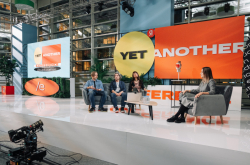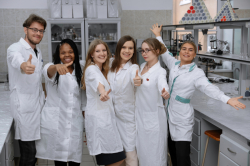This is the second time that ITMO University is hosting the international conference “Lab Space Design”, which attracts professionals in the field of modern lab design and architecture, as well as scientists, academics and students. The first conference took place in fall of 2017. At the conference, ITMO University student Veronika Nikitina won a student design competition which earned her a trip to the Skolkovo Innovation Center; later, she took an internship at Skolkovo’s Technopark and is now a staff member at Bicasa SRL’s Russian branch.
Among the second conference’s speakers were members of the academia (Skolkovo Institute of Science and Technology; ITMO University; ITMO Highpark Project Office) and the industry from countries including Italy, Germany, Austria, Singapore and Russia (Bicasa SRL; CTP SYSTEM; FAR; Fundermax; ASECOS; Esco; TROX; Gluvex; Dia-M; Rosanalit-Test; Donau Lab). This allowed guests of the conference to learn about lab design from the perspective of the companies at the forefront of that field, as well as meet representatives of educational organizations and understand what equipment they need.

One of the chief criteria for modern lab spaces is “smart” solutions. One of the trends in that area has to do with flexible lab spaces. Fabio Biffi, head of Bicasa SRL, spoke about his company’s approach to lab space planning, and explained why the main quality of a lab is its ability to transform, how the staff at Bicasa “clusterize” laboratories and which rules they follow in their work.
Bicasa was founded in 1947 by Luigi Biffi and Giuseppe Casiraghi in Sesto S. Giovanni (Milan). The post-war economic boom allowed the company to quickly become a leader in the lab equipment market. On a path of constant innovation, Bicasa became successful in the production of lab glassware (glassblowing), scientific instruments and industrial furniture, employing nearly 100 staff and producing 18,000 items. Today, the company continues its work and remains a leader in its market.

Today’s laboratories often switch the focus of their research on the fly, creating a need for quick reorganization of working spaces. Proposed projects must adapt to existing architectural solutions or those that have already been decided on. Bicasa works with construction companies and designers to ensure proper integration and design individual solutions for each project; however, the main criterion for success is the final product’s capacity to change quickly.
“Space” and “Time” control the Universe, the Earth, and our whole lives. We can only control “time” in a limited and specific “space”. Space and time is our most valued commodity. Every time we work on a project, we must optimize the “space” for many years ahead. “Time” and “Space” are key factors for any lab because each new lab is an investment that must be cherished as long as possible,” explains Fabio Biffi.

Why is space so crucial? It is always a source of expenses: purchase, rent, service, energy, staff, maintenance, etc. Lab designers must be ready to consider various factors such as energy efficiency, workflow economy, durability, integration, easy reorganization, and hi-tech solutions.
“Our philosophy is all about thinking outside the box. We’ve developed a special methodology that consists of four stages. The first stage is understanding the client’s needs. The second is understanding all the specifics of the working process at the lab. The third is developing a solution from different perspectives. And, finally, the fourth is that we always stress the added value of flexible lab spaces”, explains Fabio Biffi.

Using this methodology, the staff at Bicasa work with five categories of requirements and spaces. The first is mandatory requirements, i.e. the ones that are included in the laws and regulations of a particular country. This level usually concerns safety, temperature, and humidity, as well as lighting. Specialists analyze each space’s qualities, taking into account the number of rooms and finding the best way to integrate the working process and the available space.
The second category is that of rooms with analytical equipment; at this stage, specialists work with spaces that will host lab equipment. Some of the factors involved here are power lines, heavy equipment, and more.

The third stage involves “cluster” rooms: the spaces designed for use by particular scientists, managers or directors. Meanwhile, places that are intended for other work carried out by teams are dubbed rooms of “processes and preparation”. Here, designers take into account the technical procedure, preparations, distribution of power supply and the various aspects of the working process. These spaces, says Fabio Baffi, are the hardest to create.
The final category is “expansion rooms”. Clients usually aren’t sure what these spaces will be used for in the future. These are rooms that must be the most flexible since designers have no way of knowing how many staff will work here and what they’ll do.

The organizers of the second conference “Lab Space Design” have already outlined a list of issues that sparked the most interest among the guests and plan to discuss these topics next year at a more large-scale event involving a wide range of participants.





